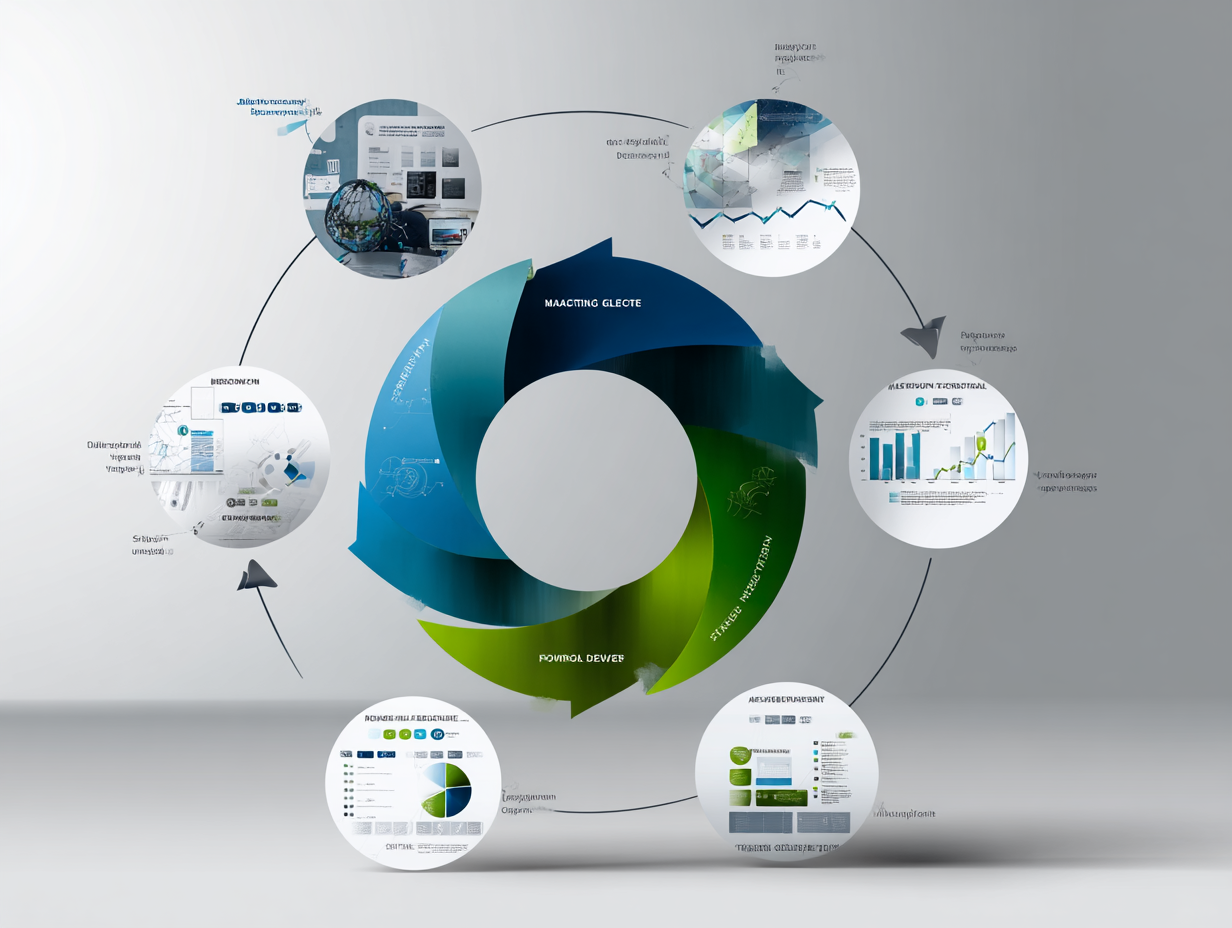Data Quality Standards for AI: Your 2025 Guide to Not Wasting Millions
With global data volumes projected to hit an almost unimaginable 181 zettabytes by 2025, we’re not just collecting information; we’re hoarding it. But here’s the rub: much of this data is dirty, inconsistent, and downright untrustworthy. Feeding it to an AI is like giving a master chef rotten ingredients and expecting a Michelin-star meal. The result? A staggering 30% of generative AI projects are expected to be abandoned by 2025 precisely because of this “garbage in, garbage out” reality. This guide is your blueprint for moving beyond the hype and implementing the robust data quality standards that actually drive success.
Table of Contents
- The High-Stakes Reality of AI Data Quality in 2025
- Current Standards: The Rulebooks for AI Data
- The Usual Suspects: Common Problems Destroying AI Projects
- Frameworks That Work: Your Blueprint for Quality
- Getting Your Hands Dirty: Practical Data Prep Techniques
- Building a Data Architecture That’s Ready for AI
- The Right Tools for the Job: Your Data Quality Toolkit
- Did It Work? Measuring and Monitoring Your Success
- Your 90-Day Plan: An Implementation Roadmap for Leaders
- Looking Ahead: Future-Proofing Your Data Strategy
- Frequently Asked Questions
The High-Stakes Reality of AI Data Quality in 2025
The AI revolution isn’t just coming; it’s here. But it’s standing on a very wobbly foundation. We’ve reached an inflection point where the quality of your data—not the cleverness of your algorithm—is the single greatest predictor of success or failure. The stakes couldn’t be higher.
The $3.1 Trillion Data Quality Crisis
Let that number sink in. According to DATAVERSITY’s Business Intelligence Report, poor data quality sucks $3.1 trillion from the US economy every single year. This isn’t some abstract figure; it’s the real-world cost of flawed data cascading through every part of a business, from botched marketing campaigns to catastrophic compliance failures. It’s a quiet, relentless drain on your bottom line.
Where It Hurts Most:
• Lost Revenue: Up to 30% of revenue vanishes because decisions are based on shaky intel.
• Operational Drag: Teams waste 40% more time wrestling with data than they should be.
• Customer Exodus: Inaccurate personalization drives away 60% more customers. They don’t feel seen; they feel misunderstood.
• Compliance Nightmares: The average data breach now costs $4.35 million. That’s a steep price for messy data.
Why a Third of AI Projects Die Before They Live
Gartner’s research paints an even grimmer picture: 85% of all AI initiatives ultimately fail, and the root cause is almost always inadequate data preparation. I’ve seen this firsthand. It’s the inconsistent formatting, the gaping holes in datasets, and the complete lack of a validation process. Companies that see this as “data janitor work” and not the foundational step it truly is are setting themselves up for failure. Investing in AI-driven data analysis isn’t a luxury; it’s survival.
A Cautionary Tale: The $2.8 Million Retail Failure
I once consulted for a major retail chain that was all-in on a new AI personalization engine. They threw $2.8 million at it. Six months later, they pulled the plug. The project lead told me later, “We had this incredible vision, but we were building it on quicksand. Every report we pulled gave us a different number for the same customer. It was a nightmare.”
Why the failure?
• Their customer data was scattered across 12 different systems, each telling a different story. It was like trying to assemble a puzzle with pieces from a dozen different boxes.
• A full 35% of their customers were ghosts, with no purchase history to analyze.
• Outdated contact information made 40% of their customer profiles essentially useless.
The result? A complete write-off of the project and an 18-month setback, all while their competitors surged ahead.
The Unfair Advantage of Clean Data
It’s not all doom and gloom. Forrester Research found that organizations with strong data quality frameworks make decisions 35% faster. Take Airbnb. By focusing on their internal data governance, they boosted engagement with their data science tools from a mediocre 30% to a solid 45%. They didn’t just clean their data; they built a culture around it. That’s the real competitive edge.
Current Standards: The Rulebooks for AI Data
So, how do we build that stronger foundation? Thankfully, we’re not starting from scratch. Successful AI implementation hinges on established data quality frameworks designed for the unique demands of machine learning.
A Quick Tour of Industry Frameworks
The NIST AI Risk Management Framework is becoming the gold standard, offering comprehensive guidelines on everything from data lineage tracking to bias detection. Think of it as the detailed architectural blueprint. Then you have ISO/IEC 25012, which provides the specific material standards for your data, and DAMA-DMBOK, which offers the practical project management plan for your governance structure.

Comparison of major data quality frameworks for AI implementation
The Dimensions of Quality: Beyond the Basics
Traditional data quality has six core dimensions, but for AI, we need to add a few more to the list. It’s not just about being accurate and complete anymore. We also need to worry about:
- Feature Stability: Is the data’s “personality” consistent over time?
- Label Quality: Are your training labels actually correct? This is a huge, often-overlooked failure point.
- Data Drift Detection: Is the world changing faster than your data can keep up?
- Bias Mitigation: Are you actively hunting for and rooting out unfair representation?
The Regulatory Minefield
The rules are getting stricter. GDPR already demands data accuracy. The upcoming EU AI Act will impose even tougher requirements on “high-risk” AI systems. Thinking about these regulations from the start isn’t just about avoiding fines; it’s about building trust and future-proofing your business when implementing AI in SMEs.
The Usual Suspects: Common Problems Destroying AI Projects in 2025
If you want to win the data quality war, you need to know your enemy. After years in the trenches, I can tell you it’s almost always the same five culprits that derail promising AI initiatives.
Data Silos: Islands Without Bridges
Nearly every business (95%!) knows data quality is vital, yet most are operating with data scattered across disconnected systems. Your CRM, email platform, and e-commerce database are like separate islands, each with its own map and language. You can’t get a complete picture if you can’t build bridges between them.
Bias: The Ghost in the Machine
Algorithmic bias is one of the gravest risks in AI. Your historical data isn’t a perfect, objective record; it’s a reflection of past decisions, including discriminatory ones. McKinsey’s research is clear: you can’t just hope for fairness. You have to systematically hunt for bias in your training data. This isn’t just a technical problem; it’s an ethical one with massive business implications.
Inconsistent Formatting: The Thousand Paper Cuts
This one seems small, but it’s deadly. Dates formatted as MM/DD/YYYY in one system and DD/MM/YYYY in another. Addresses with “Street,” “St.,” and “Str.” used interchangeably. These tiny inconsistencies are like a thousand paper cuts that will bleed your AI model’s effectiveness dry.
Missing Values: The Gaping Holes
Incomplete data is a massive headache. While some clever algorithms can work around missing values, many will simply break. Thinking about it more, the problem isn’t just that data is missing, but why it’s missing. Understanding the root cause is crucial for building a robust solution, not just patching the holes, and is a core part of machine learning fundamentals.
Data Decay: The Silent Erosion
Data isn’t static. It degrades over time. Customers move, products change, and business processes evolve. Without continuous monitoring, the high-quality data you used to train your model will slowly erode, and so will your AI’s performance. It’s a silent killer.
Frameworks That Work: Your Blueprint for Quality
A structured approach is the only way to tame the chaos. The most effective data quality frameworks blend industry best practices with your unique business needs to create a process that actually sticks.
The SMART Data Quality Framework
Let’s borrow a classic from project management and apply it to data quality. It’s simple, but it works. Your goals must be:
- Specific: Define exactly what “quality” means for each piece of data.
- Measurable: Establish clear metrics. How good is good enough?
- Achievable: Set realistic targets. You won’t go from 50% to 99% accuracy overnight.
- Relevant: Ensure your quality standards directly support a business goal.
- Time-bound: Set deadlines for improvements.
Continuous Monitoring: Your Data Quality Dashboard
You can’t fix what you can’t see. The best organizations use automated monitoring systems with real-time dashboards and alerts. This proactive approach lets you spot and fix issues before they have a chance to poison your AI models.
Governance and Accountability: Someone Has to Own It
This might be the most important part. A data quality initiative without clear ownership is doomed. You need Data Stewards—people responsible for the data in their specific domain—and a Data Governance Committee for oversight. This isn’t just an IT problem. It’s a business strategy function. For coordinating these efforts, a tool like Monday.com can be a godsend for tracking tasks. But a word of caution: while it’s great for project management, it isn’t a dedicated data governance platform, so don’t expect it to handle complex lineage or metadata management out of the box.
Getting Your Hands Dirty: Practical Data Prep Techniques
Data preparation, the so-called “data janitor work,” often eats up a staggering 60-80% of an AI project’s timeline. It’s the unseen part of the iceberg, but it’s what keeps the whole thing from sinking. Here’s how to make it more efficient.
The Six-Step Data Preparation Pipeline
A structured pipeline prevents mistakes and ensures nothing falls through the cracks.
- Discovery and Profiling: Map out your data sources. What do you have, and what shape is it in?
- Cleaning and Standardization: This is the grunt work. Zap duplicates, fix errors, and get all your formats in line.
- Integration and Transformation: Bring your data together from those lonely silos and reshape it for your AI model.
- Feature Engineering: This is where the magic happens. Create new variables from your existing data to give your model more to chew on. Understanding feature engineering is key.
- Validation and QA: Test, test, and test again. Does the prepared data meet your standards and align with business rules?
- Documentation and Lineage: Document every step. Trust me, your future self will thank you.
Automated vs. Manual: Finding the Balance
Let’s bust a myth: automation will solve everything. It won’t. Automation is fantastic for routine, high-volume tasks. But you still need human oversight. A person can spot contextual errors or subtle biases that an algorithm would miss. The key is to automate the tedious work to free up your smart people for the thoughtful work.
Rise of the Citizen Data Scientist: Self-Service Tools
The good news is you no longer need to be a coding wizard to prepare data. Modern tools with visual interfaces are empowering business users to get involved directly. This is a game-changer because it brings domain expertise right into the data prep process.
Building a Data Architecture That’s Ready for AI
Your data architecture is the foundation upon which your AI house is built. A forward-thinking design will support not just today’s projects, but the scalable needs of the future.
Data Lake vs. Data Warehouse: You Probably Need Both
The old debate of Data Lake vs. Data Warehouse is becoming obsolete. The answer is usually a hybrid approach. A Data Lake is your vast reservoir for raw data—perfect for exploration and training new models. A Data Warehouse is your curated library of business-ready data, optimized for production AI and reporting. The lake is for discovery; the warehouse is for delivery.
Real-Time vs. Batch: The Need for Speed
Many modern AI applications, like fraud detection, demand real-time data. Stream processing frameworks are essential here. However, batch processing isn’t dead. It’s still crucial for large-scale, complex transformations and analyzing historical data to find long-term trends.
Cloud-Native Prep: The Scalable Solution
The cloud is your best friend for enterprise-scale data preparation. Services like AWS Glue, Azure Data Factory, and Google Cloud Dataflow offer managed, scalable, and cost-effective solutions that plug right into their respective AI/ML ecosystems, accelerating your business process automation efforts.
The Right Tools for the Job: Your Data Quality Toolkit
Choosing the right tools can feel overwhelming. The market is exploding, expected to hit $12.26 billion by 2033. The key is to balance powerful features with usability and cost.
The Enterprise Heavyweights
For large organizations with complex needs and deep pockets, platforms like Informatica Data Quality, IBM InfoSphere, SAS Data Management, and Talend Data Quality are the go-to solutions. They’re powerful, comprehensive, and built for heavy-duty governance.
Self-Service Tools for the Rest of Us
These tools are designed to empower business analysts and other non-technical users to take control of their data.
Our Top Picks for Self-Service:
Alteryx Designer: A visual workflow builder that makes complex data prep feel like putting together LEGOs.
Microsoft Power Query: If you live in Excel and Power BI, this is your native tongue. It’s surprisingly powerful and already part of your toolkit.
Dataiku DSS: A fantastic collaborative platform that bridges the gap between business users and data scientists.
Trifacta Wrangler: Famous for its interactive and intuitive approach, making data prep feel less like a chore.
AI to the Rescue: Smarter Automation
Here’s a fun twist: we’re now using AI to clean the data for AI. These newer tools can learn from your corrections, intelligently detect anomalies, and suggest standardization rules. For coordinating all these moving parts, AI-powered project managers like Motion can be incredibly helpful. However, a reality check: Motion excels at personal and small team productivity; it’s not designed to be a full-blown enterprise project management system for a 50-person data team.
Did It Work? Measuring and Monitoring Your Success
“If you can’t measure it, you can’t improve it.” This old adage is the gospel of data quality. Objective measurement is the only way to prove the value of your efforts and drive continuous improvement.
The Metrics That Matter: KPIs for Quality
You need to track a mix of technical, business, and AI-specific metrics. It’s not just about error rates; it’s about the impact on the bottom line. Think improved decision accuracy, faster processes, and happier customers. That’s how you prove your ROI from using a comprehensive suite of AI tools.
Proving the ROI
How do you convince the C-suite this is worth the investment? You speak their language: money. Calculate the costs (tools, training) against the benefits (fewer errors, higher efficiency, better decisions). Organizations that get this right often see a 25-40% ROI in the first year alone.
Continuous Improvement: It’s a Marathon, Not a Sprint
Data quality isn’t a project you finish. It’s a cultural shift. Regular audits, gathering feedback, and constantly refining your processes are essential. I recommend a “data quality fire drill”—a planned exercise where you simulate a data corruption event to see how quickly your team can identify and fix it. It’s a great way to expose weaknesses.
Your 90-Day Plan: An Implementation Roadmap for Leaders
A structured plan turns good intentions into tangible results. Here’s a practical roadmap to get your data quality initiative off the ground.
The 30-60-90 Day Action Plan
First 30 Days: Foundation and Assessment
• The real first step? Get everyone to agree there’s a problem.
• Then, conduct a full data inventory and quality audit.
• Triage: Identify the critical issues actively hurting the business right now.
• Define what “good” looks like by setting clear quality standards.
Days 31-60: Planning and Preparation
• Go shopping for tools that fit your needs and budget.
• Build your government: Establish your governance structure and assign data stewards.
• Create the master plan with a timeline and resource allocation.
Days 61-90: Liftoff
• Start small with a pilot project on a high-priority dataset. One of the data stewards on a recent project said, “The pilot was eye-opening. For the first time, our sales and marketing teams were actually speaking the same language because they were working from the same trusted data.”
• Train your team on the new tools and processes, emphasizing how to explain concepts to non-technical stakeholders.
• Flip the switch on your monitoring systems and start tracking progress.
Budgeting for Quality
Plan on dedicating 3-5% of your total IT budget to data quality. Initial costs can range from $50,000 to over $500,000. But remember that retail company? Their inaction cost them $2.8 million. A solid quality program often pays for itself within 12-18 months.
Looking Ahead: Future-Proofing Your Data Strategy
The world of AI is moving at lightning speed. Your data quality strategy needs to be agile enough to keep up.
The Impact of What’s Next
Generative AI, LLMs, and autonomous systems need incredibly diverse, high-quality data and constant monitoring for things like factual drift and emerging biases. Your quality framework must evolve to handle these new demands, often with the help of new AI productivity tools.
Predictions for 2026-2027
Here’s what I see on the horizon:
- Autonomous Quality Management: AI systems that find and fix data issues on their own.
- Real-Time Quality Assessment: No more quarterly audits. Think continuous, instant feedback.
- Federated Quality Systems: Managing data quality across organizational boundaries.
How to Prepare Now: Invest in flexible platforms, build cross-functional quality communities, and create a culture of continuous learning. Design your systems as if your data will grow 10x tomorrow. Because it might. This makes regular monitoring of your AI performance more critical than ever.
Final Thoughts: Your Next Move Toward Data Excellence
Let’s be blunt. Data quality isn’t a “nice to have” IT project. It’s the single most critical factor determining whether your investment in AI will pay off or go down the drain. With 85% of AI projects failing on the back of bad data, ignoring this is a form of business malpractice.
The frameworks and strategies we’ve discussed are your roadmap. But a map is useless if you don’t take the first step. That first step is a brutally honest assessment of where you stand today. From there, you can define your standards, build your governance, and start creating a culture that treats data as the priceless asset it is.
This isn’t a one-and-done task. It’s a new capability, an ongoing commitment. But the dividends—in model accuracy, operational efficiency, and real business outcomes—are immense. The companies that master their data today are the ones that will dominate the AI-powered marketplace of tomorrow.
Frequently Asked Questions
What are the most important data quality standards for AI?
Beyond the basics like accuracy and completeness, you have to focus on representativeness to fight bias. Also, things like data timeliness and consistency are non-negotiable. Frameworks like the NIST AI Risk Management Framework are your best bet for a comprehensive approach.
How do I know if my data is ready for AI?
Do a quick health check. Are fewer than 5% of your values missing? Are error rates below 2%? Is your formatting consistent? More importantly, do you have enough historical data to even train a model? A data profiling tool will give you a brutally honest answer.
What percentage of AI projects really fail because of bad data?
The numbers are grim. Gartner predicts 30% of generative AI projects will be abandoned by 2025 due to poor data. Some studies put the failure rate for all AI initiatives as high as 85%, with bad data being the primary culprit.
Which data prep tools are best for non-techies?
Great tools now exist for non-coders. Alteryx Designer is a visual, drag-and-drop workflow. Microsoft Power Query is built right into Excel and Power BI, so it feels familiar. Tools like Dataiku and Trifacta are also fantastic for empowering business users.
Honestly, how long does data prep take for an AI project?
It consistently eats up 60-80% of the entire project timeline. It’s the biggest bottleneck. For a small project, maybe a few weeks. For a large, messy enterprise dataset, it can easily take 3-6 months. Don’t underestimate it.
What’s the real difference between data cleaning and data preparation?
Think of it this way: cleaning is one step within the larger process of preparation. Cleaning is fixing what’s broken in one dataset (errors, duplicates). Preparation is the whole shebang: cleaning, plus integrating data from multiple sources, transforming it, and formatting it perfectly for a specific AI model.
How much should we budget for data quality in 2025?
A good rule of thumb is 3-5% of your total IT budget. An initial implementation might run from $50,000 to over $500,000, depending on your size. But the cost of not doing it—in failed projects and bad decisions—is far higher.
How do I measure the ROI of fixing our data?
Track the “before and after.” How much did your error rates drop? How much faster are you making key decisions? Quantify these gains in efficiency and revenue, and set them against the cost of your program. The business case often makes itself.
Can AI tools really help automate this work?
Yes, and they’re getting smarter. AI can automate the grunt work: flagging duplicates, suggesting standardization rules, and detecting anomalies. But it’s not a silver bullet. You still need a human in the loop for business context and strategic decisions.
How do I get my boss to invest in data quality?
Don’t talk about “data cleansing.” Talk about business impact. Frame it in terms of risk (“A data breach here could cost millions”), cost (“We’re wasting X hours a week on manual fixes”), and opportunity (“Our competitor is making decisions 35% faster”).
Isn’t data governance the same as data quality?
No, but they’re deeply connected. Governance is the overall strategy, policy, and structure—the constitution. Quality is a key function within that government, focused on the hands-on processes to ensure data is fit for use. You can’t have one without the other.






Leave a Reply